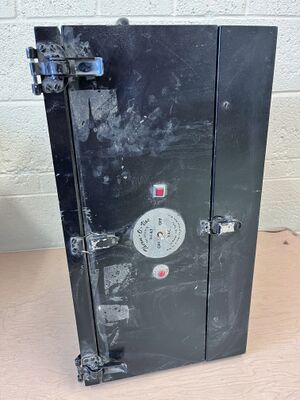Difference between revisions of "Vacuum Former"
m |
m |
||
| Line 1: | Line 1: | ||
{{Infobox vacuumFormer}} | {{Infobox vacuumFormer}} | ||
| − | |||
| − | |||
==What is vacuum forming?== | ==What is vacuum forming?== | ||
Vacuum forming is a thermoforming manufacturing method used to shape plastic. | Vacuum forming is a thermoforming manufacturing method used to shape plastic. | ||
| Line 13: | Line 11: | ||
<br /> | <br /> | ||
| − | ==Access== | + | ==Access & Use== |
| − | <br /> | + | Access policy not yet established<br /> |
==Materials== | ==Materials== | ||
| + | The default frame size of the Nichols Model 10-B is 14" x 20", and thermoplastic material will need to be this exact size. | ||
| + | |||
| + | There are plans to create removeable frame inserts to allow for smaller, more standard sizes of material. This will reduce plastic waste and also increase the vacuum power. | ||
| + | |||
| + | Recommended material thickness is 0.2" to 0.6" (approx. 0.5mm to 1.5mm). Most types of thermoplastics will work, but these types are recommended: | ||
| + | {| class="wikitable" | ||
| + | |+ | ||
| + | !Plastic type | ||
| + | !0.5mm heating time | ||
| + | !1mm heating time | ||
| + | !1.5mm heating time | ||
| + | |- | ||
| + | |HIPS (high impact polystyrene) | ||
| + | |15 seconds | ||
| + | |30 seconds | ||
| + | |45 seconds | ||
| + | |- | ||
| + | |PETG (polyethylene terephthalate glycol) | ||
| + | |15 seconds | ||
| + | |30 seconds | ||
| + | |45 seconds | ||
| + | |- | ||
| + | |ABS (acrylonitrile butadiene styrene) | ||
| + | |20 seconds | ||
| + | |40 seconds | ||
| + | |60 seconds | ||
| + | |} | ||
| + | Heating times are approximate. | ||
| + | |||
| + | LDPE (low density polyethylene) is not recommended as the machine cannot heat the plastic hot enough to mold. | ||
<br /> | <br /> | ||
| − | |||
==Mold Design== | ==Mold Design== | ||
Revision as of 22:35, 20 January 2024
What is vacuum forming?
Vacuum forming is a thermoforming manufacturing method used to shape plastic.
- A mold is placed on a surface that contains many small holes
- A sheet of plastic is clamped in a frame and heated until soft
- The hot plastic is pulled over the mold, and a vacuum sucks through the small holes and forms the plastic over the mold
- The result is a plastic impression of the mold’s contour
Vacuum forming can be used to mass produce functional items such as plastic packaging, and for creative works such as resin molds and costume pieces.
Access & Use
Access policy not yet established
Materials
The default frame size of the Nichols Model 10-B is 14" x 20", and thermoplastic material will need to be this exact size.
There are plans to create removeable frame inserts to allow for smaller, more standard sizes of material. This will reduce plastic waste and also increase the vacuum power.
Recommended material thickness is 0.2" to 0.6" (approx. 0.5mm to 1.5mm). Most types of thermoplastics will work, but these types are recommended:
| Plastic type | 0.5mm heating time | 1mm heating time | 1.5mm heating time |
|---|---|---|---|
| HIPS (high impact polystyrene) | 15 seconds | 30 seconds | 45 seconds |
| PETG (polyethylene terephthalate glycol) | 15 seconds | 30 seconds | 45 seconds |
| ABS (acrylonitrile butadiene styrene) | 20 seconds | 40 seconds | 60 seconds |
Heating times are approximate.
LDPE (low density polyethylene) is not recommended as the machine cannot heat the plastic hot enough to mold.
